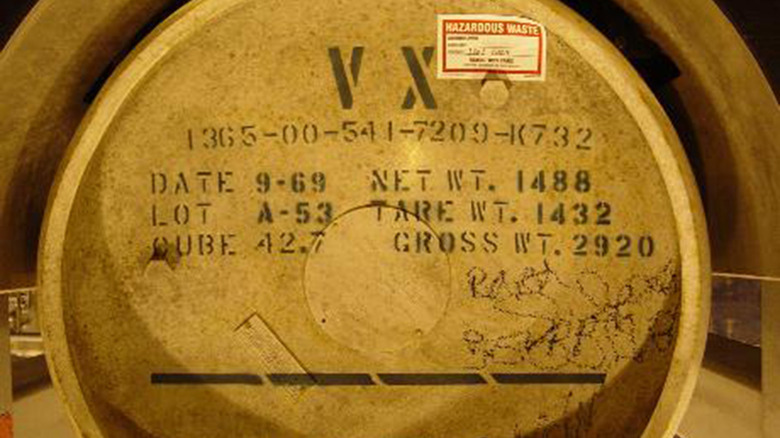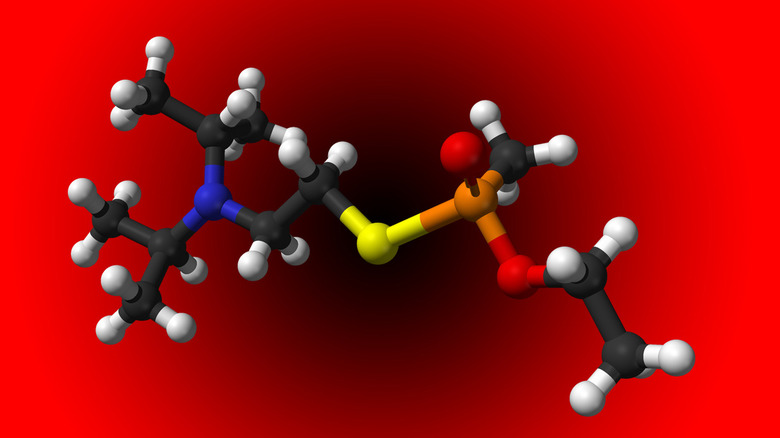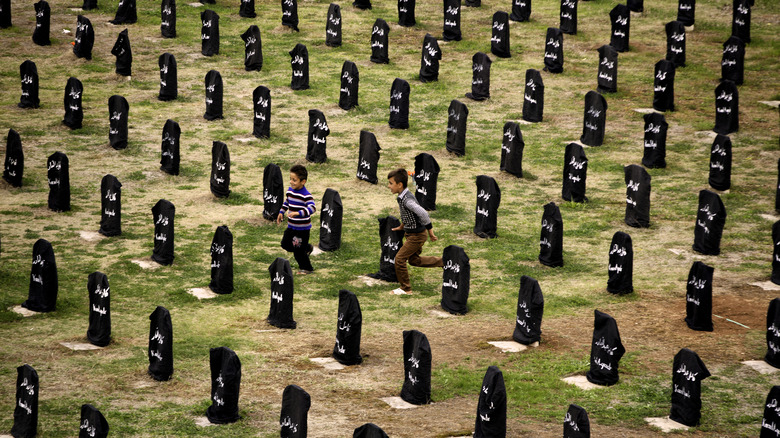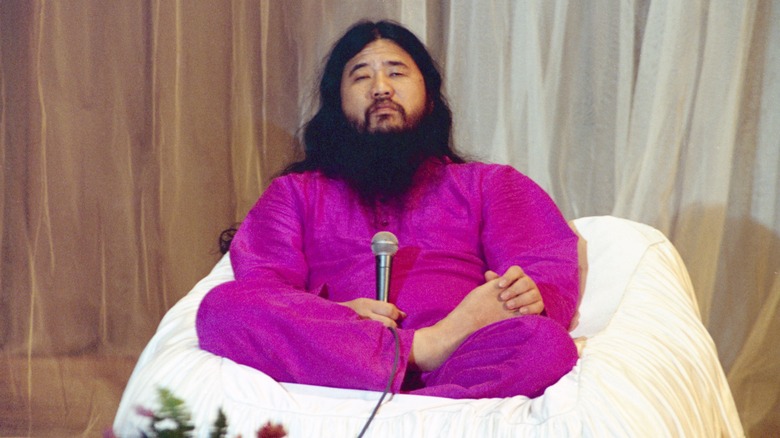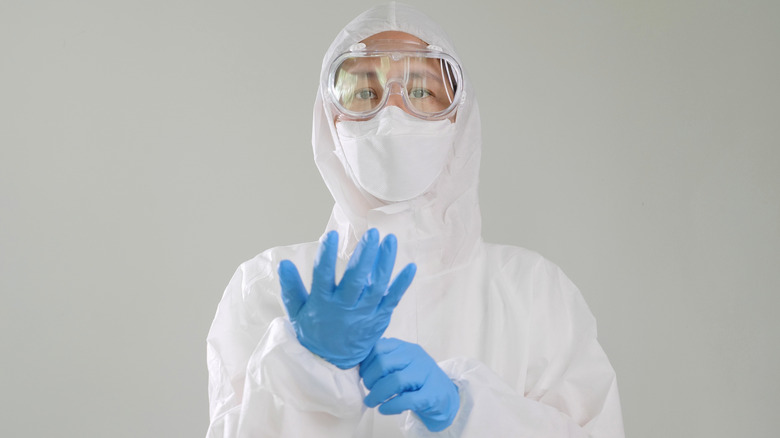What Is The VX Nerve Agent That Was Used To Kill Kim Jong-Un's Brother In 2017?
Few weapons made by man have been so ruthlessly effective and so abjectly terrifying as chemical weapons. An early account of chemical warfare comes from a 3rd-century attack by Sasanians on a Roman town. The Sasanian Persians burned sulfur and bitumen inside a sap during the siege of a city, horrifically killing the unfortunate Romans occupying the tunnel (via American Journal of Archaeology).
Since then, we have continued to come up with more brutally efficient ways of using chemicals to kill each other. The peak of their use came during World War I, when mass-produced chemical weapons killed 100,000 people on both sides of the conflict (via International Business Times). In the 1930s, German scientists, trying to make a more effective insecticide, accidentally created a new class of chemical weapon called a nerve agent that was more lethal than anything ever made. Fearing retaliation from the Allies, the Germans never deployed their new weapons in combat (via Nature).
After the war, the pieces of the German chemical weapons industry were picked up by the Allied armies, who continued to refine these new weapons (via Chemical & Engineering News). In the 1950s, the British (also looking to make a pesticide) created the most lethal nerve agent to date: VX (via Council on Foreign Relations).
What makes VX so deadly?
Like all nerve agents, the basic mechanism of VX is to interrupt the function of acetylcholinesterase (via National Research Council). This molecule is responsible for the chemical breakdown of acetylcholine, a neurotransmitter. Acetylcholine is found throughout the body and used in a number of processes involving the central nervous system as well as the autonomous and voluntary muscular systems (via Britannica).
If you stop producing acetylcholinesterase and acetylcholine is allowed to build up, your body undergoes a cascade of negative health effects. The lungs begin to fill with fluid, the heart rate slows, and the pupils shrink. Muscles become weak and begin twitching uncontrollably. You become anxious, undergo mood swings, and your speech and balance become impaired. If you're lucky enough to survive exposure, you could be left with long-term neurological and psychological problems.
VX is an odorless and tasteless substance. It's an oily liquid at room temperature that evaporates very slowly and sticks around for a long time. Perhaps most frightening of all is the fact that it takes as little as 6 milligrams to kill someone (via StatPearls). That's smaller than a drop of water.
Weapon of war
The use of VX in a military conflict has never been definitively confirmed, but it's suspected to have been used in two different wars in 1988. In the Levant, Iraq and Iran were embroiled in a years-long conflict over ideology and territory. After the Kurdish city of Halabja was occupied by Iranian forces and pro-Iranian Kurdish rebels in March, Saddam Hussein retaliated against the occupiers and the town by unleashing the largest chemical weapons attack on a civilian population, killing 3,500 to 5,500 (via Science). Iraq reportedly used a cocktail of nerve agents in the attack, one of which was VX (via France24).
Around the same time, it's alleged that Cuba unleashed a chemical attack in Angola's decades-long civil war in support of the Marxist government. The Angolan Civil War was one of the many proxy wars between the U.S. and the USSR during the 1980s. Russian-backed Cubans fought on one side, and American-backed South Africans fought on the other. In an attempt to dislodge entrenched rebel groups, the Cuban army is reported to have used chemical weapons in the Angolan jungle. Investigators on the ground found traces of VX (via the U.S. Government Printing Office).
Chemical terrorism
In 1994, VX ceased being a weapon of armies and nations and became a tool of assassination and terrorism. The Japanese cult, Aum Shinrikyo, started as a new-age spiritual group in the 1980s but soon began incorporating apocalyptic beliefs into its philosophy (via BBC).
Aum Shinrikyo got its first taste of murder in 1988 when a member was accidentally killed, and the group clandestinely destroyed the body. When someone tried to leave the cult the next year, instead of risking exposure, the cult killed and disposed of them. In 1989, the cult went so far as to kill a lawyer and his family for helping people leave the organization (via Nuclear Threat Initiative).
By late 1993 it had begun to embrace chemical weapons as a means of achieving its goals. The cult was able to recruit a chemist who produced a stockpile of sarin and VX for the group (via Global Security: Health, Science, and Policy). At least three people were poisoned with VX in 1994, one of whom died. Aum Shinrikyo would go on to kill 19 and injure thousands with the nerve agent sarin between 1994 and 1995 (via Center for Nonproliferation Studies).
Political assassination
VX was again used as a tool for assassination over 20 years later in Malaysia. Before Kim Jong-un was the heir-apparent of North Korea, his half-brother Kim Jong-nam was first in line for the throne of the Hermit Kingdom. But Jong-nam's taste for decadence led to embarrassment for the Kim family, and after his younger brother's rise to power, he was considered a threat (via GQ).
In 2017 in the Kuala Lumpur airport, Kim Jong-nam was killed with VX. But unlike the Aum Shinrikyo cultists, the killers never directly handled VX, and they had no idea what they were doing. Instead, two women were recruited to do what they thought were prank videos where they would smear oil on the face of an unsuspecting mark. Unbeknownst to either woman, they were each given two chemical halves of VX. Each was harmless on its own, but when brought together, they reacted to form the deadly nerve agent. Kim Jong-nam was dead within 20 minutes, dying in an ambulance on his way to the hospital (via Global Security: Health, Science, and Policy).
How scared should we be?
If, by some disastrously unfortunate turn of events, you do find yourself contaminated with VX, there are a few things you can do. First, leave the area where it happened. If you're inside, go outside so that you're not trapped with the nerve agent. Next, remove your clothes and thoroughly wash yourself with soap and water. There's not much to be done about breathing in VX, but even a drop on your skin can be lethal. Finally, go to the ER. If you've been exposed, you're going to need a doctor (via CDC).
You're also going to want two medicines. The first is atropine, which blocks the effects of acetylcholine, the neurotransmitter VX causes to over accumulate in the body. The second is pralidoxime, and it helps restore the ability of acetylcholinesterase (the chemical VX inhibited) to break down acetylcholine again (via CDC).
But we probably don't have to worry about VX. The U.S. is the only country that has admitted to producing it, although Russia has a similar nerve agent in its arsenal. The fact that belligerent countries like North Korea and apocalyptic terror groups like Aum Shinrikyo can produce it is worrying, but we can take comfort in the fact that they can't produce it on a large scale. And it's worth noting that half of Aum Shinrikyo's attempts at using VX were failures (via Center for Nonproliferation Studies).
